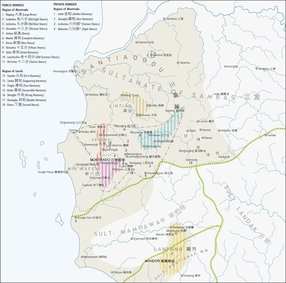
Back República Kongsi Spanish Federasi kongsi ID 공사공화국 Korean Republik kongsi Malay สาธารณรัฐกงสี Thai Cộng hòa kongsi Vietnamese 公司共和國 Chinese

| History of Indonesia |
|---|
 |
| Timeline |
|
|
The kongsi republics (Chinese: 公司共和國), also known as kongsi democracies (Chinese: 公司民主國) or kongsi federations (Chinese: 公司聯邦), were self-governing political entities in Borneo that formed as federations of Chinese mining communities known as kongsis. By the mid-nineteenth century, the kongsi republics controlled most of western Borneo. The three largest kongsi republics were the Lanfang Republic, the Heshun Confederation (Fosjoen), and the Santiaogou Federation (Samtiaokioe) after it had split from the Heshun.[1]
Commercial kongsis were common in Chinese diasporic communities throughout the world, but the kongsi republics of Borneo were unique in that they were sovereign states that controlled large swaths of territory.[1] This characteristic distinguishes them from the sultanates of Southeast Asia, which held authority over their subjects, yet did not control the territory where their subjects resided.[1]
The kongsi republics competed with the Dutch over the control of Borneo, culminating in three Kongsi Wars in 1822–24, 1850–54, and 1884–85. The Dutch eventually defeated the kongsi republics, bringing their territory under the authority of the Dutch colonial state.[2]
Kongsi federations were governed by direct democracy,[3] and were first called "republics" by nineteenth century authors.[4] However, modern scholars hold different views as to whether they should be regarded as Western-style republics or a completely independent Chinese tradition of democracy.[5]
- ^ a b c Heidhues 2003, p. 55.
- ^ Heidhues 2003, p. 116.
- ^ Tai Peng 1994, p. 6.
- ^ Heidhues 2003, p. 60.
- ^ Tai Peng 1979, p. 104.
© MMXXIII Rich X Search. We shall prevail. All rights reserved. Rich X Search